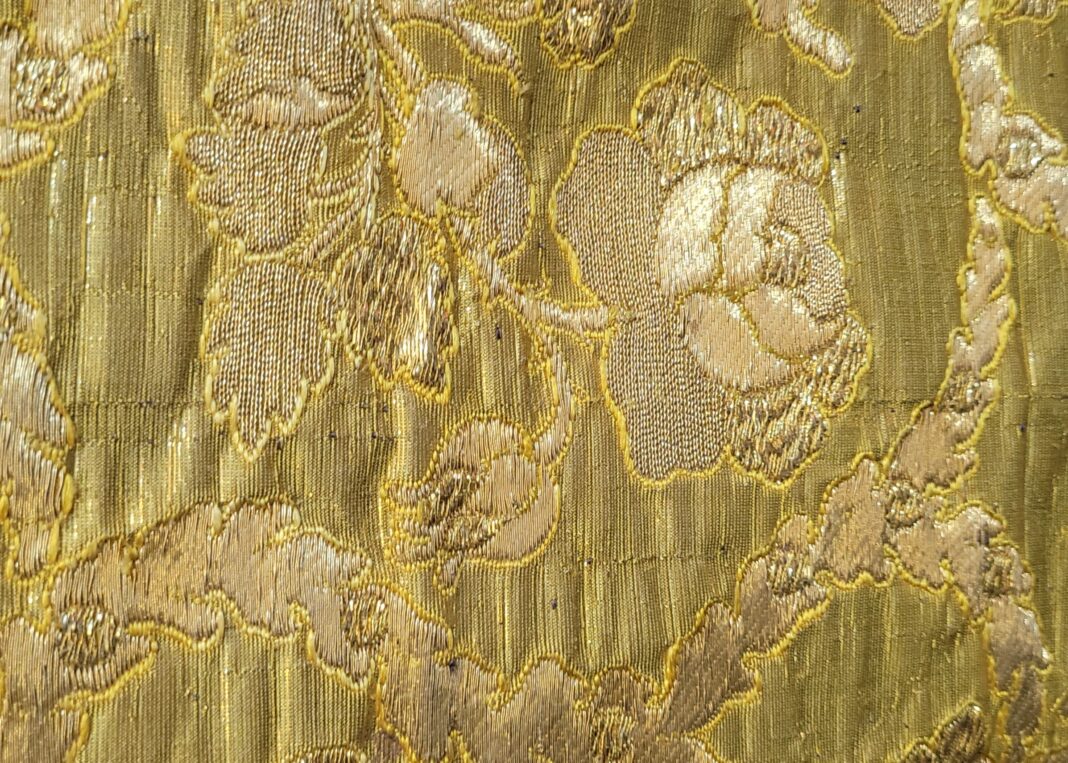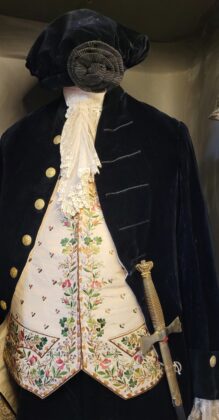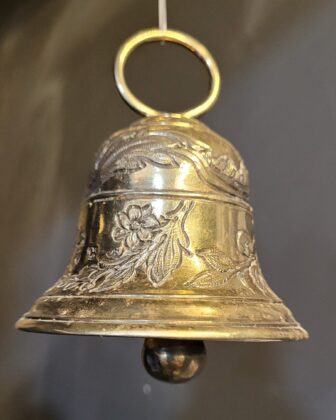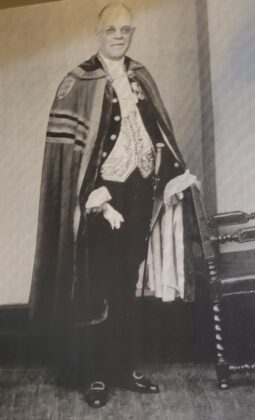The latest in the series on objects from Rye Castle Museum and what they tell us about the history of Rye and the surrounding area.
The canopy cloth, silver gilt bell and ceremonial dress used by the Barons of the Cinque Ports at the coronation of George III
The recent coronation of Charles III has shone the light on one important part that Rye and the Cinque Ports have played in the history of our country as well as how traditions, established in the 12th century, have lived on. Since 1189 and the coronation of Richard I, representatives of the Cinque Ports, the barons, have taken part in all the coronation of all monarchs, except those of William IV and Queen Victoria. Recently, our mayor, Andi Rivett, along with 13 other barons attended the coronation of Charles III as representatives of the Cinque Ports.
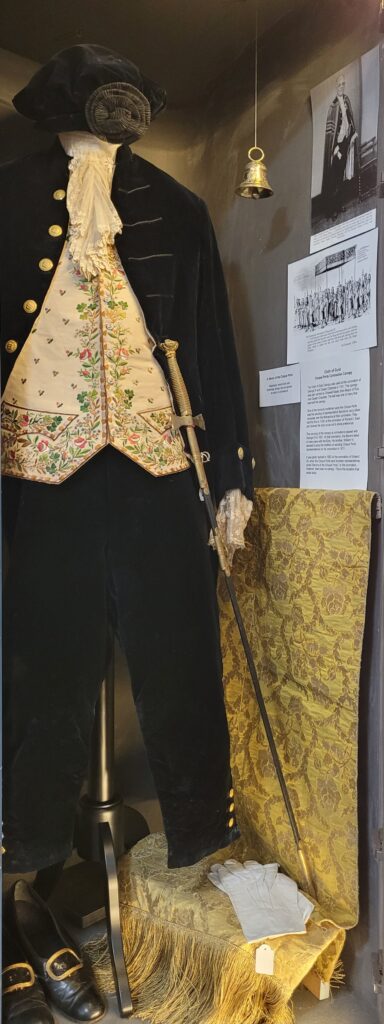
Many may not know that a display in the Rye Castle Museum at East Street is dedicated to the role of the barons in the coronation ceremony. It includes part of the cloth of gold canopy held over Queen Charlotte at the coronation of George III in 1761 and the silver gilt bell that was attached at the corner of the canopy, along with the breeches, shoes, waistcoat, hat, gloves and sword worn by Baron Chiswell Slade (the mayor of Rye) at the coronation. Few of the canopies or staves and bells survive, so this portion of the canopy, in Rye Museum, is quite rare.
The history of the Cinque Ports began during the reign of Edward the Confessor (1042-1066), when the group of ports, made up of Dover, Sandwich, Romney and later Hythe and Hastings, were required to supply the king with ships and men, once a year for 15 days, as part of the defence of the realm and for the protection of cross Channel ships. In return for this service, these ports were granted self-government and were able to control their own legal and taxation systems. Through a series of royal charters, the ports were free to raise taxes, had their own courts to prosecute and punish crimes and could claim wrecks from the sea or shore. These ports became some of the most important in the country but by 12th century the original five ports were unable to carry out all the services required by the king, so Rye and Winchelsea joined the Confederation of the Cinque Ports as ‘members ‘or ‘limbs’, later being given the special status of ‘ancient towns’.
A further privilege granted was the right of representatives of the Cinque Ports, known as barons, to attend coronations. The barons were given the responsibility to carry a canopy held up by silver staves, over the heads of the king and queen in the coronation procession and after, to sit at the chief table at the right-hand side of the king for the dinner in Westminster Great Hall.
Describing the coronation of Henry III and Queen Eleanor in 1236, Matthew Paris wrote: “The Barons of the Cinque Ports carried over the king wherever he went the silken cloth four-square, purple supported by four silvered spears with four little silver-guilt bells, four barons being assigned to every spear… “
After, the barons could take away the canopy, the silver staves, and bells that were hung at the corners, back to the ports (taking it in turns), as their fee. Rye received the canopy in 1483 after the coronation of Richard III and Queen Anne.
In 1547 after the coronation of Edward VI, Rye was the intended recipient of the canopy and the staves. However, the mayor of Rye, Mr W Roberthes, only received a staff with the rest taken by barons from Romney and Sandwich. It was only after some arguments, that Rye received its share.
At the coronation of James 1 in 1603 “the barons wore one scarlett gown, down to the ankle, faced with crimson satin, gascoigne hose, crimson silk stockings and velvet shoes, and black velvet cap”. Such matters were expensive and each town had to pay its coronation barons 43s. 4d. each as an allowance for the scarlet liveries.
There was further controversy after the coronation of Charles II in 1661. Much to the consternation and anger of the barons, the king’s footmen grabbed the canopy as the barons approached the banquet. There ensued much struggling as the barons attempted to grab it back but were outnumbered and were soon dragged away from their allotted table to the end of Westminster Hall. Seeing that the barons’ table near the king was free, various judges and bishops jumped at the chance of the honour of being at the right hand of the king, therefore usurping the rightful place of the barons. Samuel Pepys recorded the event in his diary: “…the poor barons… naturally unwilling to lose their dinner, were necessitated to eat it at the bottom of the second table below the Masters in Chancery and other of the long robe!”
When the king heard of the actions of his footmen they were swiftly dismissed.
Later, at the coronation of William and Mary in 1689, the barons again were refused their place at the right hand of the king and queen at the banquet, and from that time on were no longer granted this privilege.
However, the barons’ role as bearers of the canopy continued, with James Lamb, mayor of Rye, acting as baron for George II and Queen Caroline in 1727. This continued until the coronation of George IV in 1821 (attended by William Philips Lamb as baron, a portrait of whom, dressed in his mayoral regalia, can be seen in Lamb House). It was reported that the barons had partaken rather too freely of the wine, resulting in the canopy being unsteadily held aloft causing a near-miss with the king’s head. Thereafter, the barons no longer took on this role.
Despite losing their privileges and not attending the coronations of William IV and Victoria, the barons fought to keep their right to attend and in 1901 this was granted. The Cinque Ports sent fourteen representatives to the coronation of Edward VII but no longer carried the canopy. Barons have been invited to all subsequent coronations with Rye’s mayor, Andi Rivett, being the most recent to become a baron and take his place at the coronation of Charles III.
Museum opening hours
The Rye Castle Museum has two sites, one in a former bottling factory in East Street and the other at the Castle / Ypres Tower.
Castle / Ypres Tower is open daily throughout the year. March 30 to October 31 from 10:30am to 5pm. November 1 to March 29 from 10:30am to 3:30pm.
East Street is open at weekends from April to October from 10:30am to 4:30pm (subject to availability of volunteers).
Image Credits: Rye Castle Museum/Juliet Duff .



